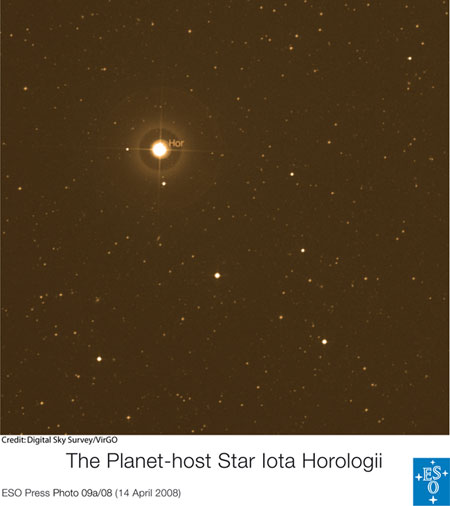Home of Drifting Star Found

Bylistening to the "ringing" of a nearby planet-harboring star,astronomers have for the first time identified the birthplace of one of our galaxy'smany drifting stars.
Theyellow-orange star IotaHorologii, located 56 light-years away near the southern-sky constellationHorologium ("The Clock"), was discovered to harbor a planet about twotimes the size of Jupiter in 1999.
But untilnow, scientists were unable to identify the exact characteristics of the star,or where in the galaxy it had formed.
The starcurrently resides in the "Hyades stream,"a large number of stars that move in the same direction, many of which arethought to be so-called "drifting stars" ? stars that were displacedfrom their birthplace. The new method used by the team of astronomers toidentify Iota Horologii's stellar parentage involves studying how sound wavesmove through a star.
Theapproach could be used to ID other orphaned stars ? estimated to make up about20 percent of the stars within 1,000 light-years of the sun ? and shed morelight on how these stars move in the galaxy.
Goodvibrations
SylvieVauclair of the University of Toulouse in France and her team of astronomersused a technique called "asteroseismology" to unlock the elusiveproperties of the star.
Get the Space.com Newsletter
Breaking space news, the latest updates on rocket launches, skywatching events and more!
"Inthe same way as geologists monitor how seismic waves generated by earthquakespropagate through the Earth and learn about the inner structure of our planet,it is possible to study sound waves running through a star," Vauclairexplained.
This"ringing" of the star gives scientists information about the physicalconditions in the star's interior. With observations taken from the HARPSspectrograph, which is mounted on the European Southern Observatory's3.6-meter telescope at La Silla, Chile, up to 25 "notes" wereidentified by the team.
"Youcan analyze the sound and analyze the harmonies, and you can get the harmoniesof the star," Vauclair said. "And different stars have differentharmonies."
These notesgave the astronomers a precise portrait of the star: its temperature is 6,150 Kelvin,its mass is 1.25 times that of the Sun, and it is 625 million years old. It isalso 1.5 times as metal-rich as the sun, which was the clue astronomers neededto figure out where the star came from ? the Hyades cluster.
"IotaHorologii has the same metal abundance and age as the Hyades cluster,"Vauclair said, adding that "the chance is really low that it's acoincidence."
The team'sfindings are detailed in a Letter to the Editor in the journal Astronomy andAstrophysics.
Drifters
Other stellardrifters inhabit these so-called "streams" that travel with the samevelocity as nearby clusters, with some of them suspected to have formed in thecluster. In the Hyades stream, previous research has shown that "most ofthe stars have not been formed in the Hyades," Vauclair said. Only about15 percent were estimated to come from the Hyades cluster.
"Thisguy [Iota Horologii] would be one of this 15 percent," Vauclair told SPACE.com."I think it's the first star for which we have this result."
Vauclairsays the star must have formed together with the other stars of the Hyadescluster, but then must have slowly drifted away, to its current spot more than130 light-years from its birthplace.
Previousresearch has shown that quite a few stars follow unusualtrajectories compared to most stars, which orbit the Milky Way's center. Itis thought that the wanderers may be gravitationally stirred by the spiral armsof the galaxy, which could deflect the motions of the stars. The stars mayeventually get sucked into other arrangements of stars with more normal pathsaround the galactic center, which is thought to have happened to most of thestars in the Hyades stream, Vauclair said.
Plenty ofother clusters have associated streams, and the same method that Vauclair andher team used to ID Iota Horologii could be used to pinpoint where other starscame from, shedding light on how they got to where they are now, she said.
- Video: Eavesdropping on the Sun
- The 10 Brightest Stars
- Top 10 Star Mysteries
Join our Space Forums to keep talking space on the latest missions, night sky and more! And if you have a news tip, correction or comment, let us know at: community@space.com.

Andrea Thompson is an associate editor at Scientific American, where she covers sustainability, energy and the environment. Prior to that, she was a senior writer covering climate science at Climate Central and a reporter and editor at Live Science, where she primarily covered Earth science and the environment. She holds a graduate degree in science health and environmental reporting from New York University, as well as a bachelor of science and and masters of science in atmospheric chemistry from the Georgia Institute of Technology.









